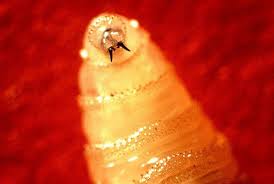What is screwworm and what causes it?
Screwworms are the larvae (maggots) of a certain fl y species that feed on living tissue of animals. Although these fl ies have been eradicated from the United States, Mexico and Central America, they can still be found in some countries of South America, the Caribbean, Southeast Asia, India and Africa. One of the concerns with this parasite is that it will be reintroduced into the United States from an infested animal. The larvae cause great damage to the hides of animals as well as have the potential to cause death in aff ected animals.
What animals get screwworm?
Screwworms can infest all warm blooded animals, including birds. Most cases occur in cattle, goats and sheep.
How can my animal get screwworm?
Screwworms (vector) are transmitted when a female fl y lays her eggs on a superfi cial wound of an animal. Screwworms can infest a wide variety of wounds (e.g. tick bites, dehorning or branding wounds, wire cuts, and other injuries). Navels of newborn mammals are a common site for screwworm infestation. Wounds infested by screwworms often attract other female screwworms and multiple infestations are common. Screwworm fl ies can travel from over 12 miles.
How does screwworm affect my animal?
The screwworm eggs laid in the wound hatch into larval screwworm, which feed on the living tissue of the animal. Screwworm infestations are diffi cult to detect at fi rst. Slight movement might be seen inside a wound, but the larvae feed and the wound gradually enlarges and deepens. A blood tinged fl uid with a distinct odor may seep from the wound. As many as 200 vertically oriented larvae may be packed deep inside the wound. Infested animals usually separate from the herd and lie down in shady areas. Discomfort, decreased appetite and lowered milk production are common. Untreated animals may die in 7 to 14 days from toxicity or secondary infections.
Can I get screwworm?
Yes. Humans can get screwworm (vector) in the same manner as animals – by fl ies depositing larvae on an open wound.
Who should I contact, if I suspect screwworm?
In Animals – Contact your veterinarian immediately. Screwworms are not currently found in the U.S.; suspicion of disease requires immediate attention. In Humans – Contact your physician immediately.
How can I protect my animals from screwworm?
Animals imported from countries where the screwworm fl ies exist must be carefully examined by veterinarians upon entry into the United States. Wounds should be closely checked for any screwworm eggs or larvae that could be there. Observe your animal for signs or the presence of screwworms. Screwworm eggs are creamy and white and deposited in a shingle-like manner on or near the edges of superfi cial wounds. The larvae are cylindrical with one pointed end and one blunt end and have rings of dark brown spines around the body. Female screwworm fl ies are larger than a housefl y with a dark blue to blue-green body and reddish-orange head.
How can I protect myself from screwworm?
While traveling in countries that have screwworms, pay careful attention to any wounds to help protect yourself from screwworm infestation









